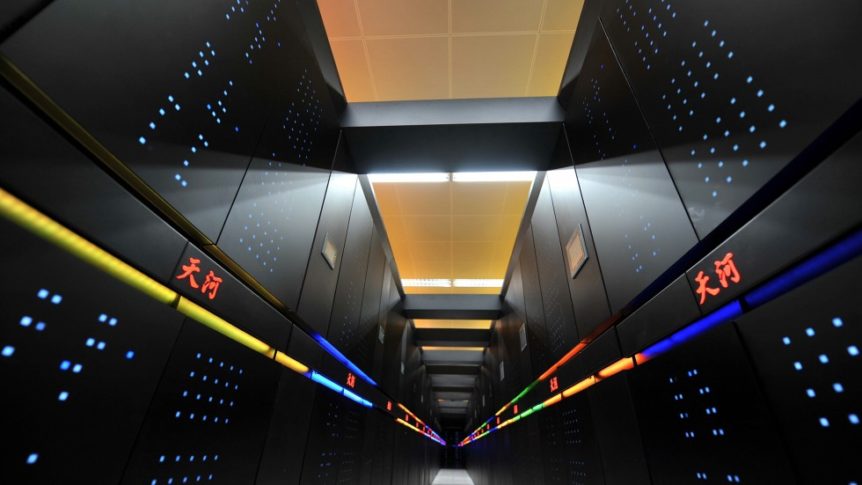The world’s top chipmaker gets left in the dust in the supercomputer race.
Intel (NASDAQ:INTC) likely won’t power the world’s top supercomputers anymore, following two stunning announcements from the Chinese government and IBM (NYSE:IBM).
The Chinese government unveiled Sunway TaihuLight, a supercomputer which has theoretical peak performance of 124.5 petaflops, making it the first supercomputer to break the 100 petaflop barrier. A single petaflop equals about one quadrillion calculations per second. The TaihuLight runs entirely on Chinese hardware, using ShenWei CPUs developed at the Jiangan Computing Research Lab in Wuxi. That means Intel, which previously provided Xeon chips for the country’s Tianhe-2 supercomputer, has been cut out of China’s supercomputer loop.
Shortly afterwards, IBM revealed details about its new supercomputer, Summit, which will be deployed in the U.S. Department of Energy’s Oak Ridge National Laboratory in early 2018. The machine was originally intended to run at 150 petaflops, but IBM now claims that it could achieve peak performance of 200 petaflops. The Summit also doesn’t use any Intel silicon — it runs entirely on IBM’s Power9 microprocessors and Nvidia’s (NASDAQ:NVDA) next-gen Volta GPUs.
How did Intel fall behind?
Intel’s sudden drop in the supercomputer charts occurred for two main reasons. First, the U.S. government blocked Intel from selling new Xeon chips to Chinese supercomputers last April, citing concerns about their role in nuclear research. The Chinese government had ordered tens of thousands of new Xeon chips from Intel to upgrade Tianhe-2’s average speed from 33 petaflops to over 110 petaflops.
That interference was controversial, as was Intel’s compliance, since the U.S. Department of Energy had run its own nuclear tests since live tests were banned in 1992. Sequoia, the weapon-testing supercomputer, had been the fastest in the world until it was dethroned by Tianhe-2 in 2013, so it seemed like the Xeon ban was just a petty way to kneecap China in the supercomputer race.
Meanwhile, IBM has been pairing its Power processors with Nvidia’s high-end GPUs for a simple reason — GPUs generally outperform stand-alone CPUs in machine learning. IBM claims that pairing Nvidia’s Tesla K80 GPUs with its Power-based chips enables its Watson AI platform to answer questions 1.7 times faster. Nvidia claims that the K80 runs key science applications “two to five times” faster than Intel’s Xeon Phi 7120 CPU. The combination of the new Power9 CPUs and Volta GPUs in the Summit could yield even more impressive results.
What does this all mean for Intel?
Losing the Chinese supercomputer orders last year reportedly cost Intel between $1 billion to $1.3 billion in revenue. That’s equivalent to about 6% to 8% of its $16 billion in Data Center revenue in fiscal 2015.
Losing Xeon sales in China is bad for Intel, which posted just 9% data center revenue growth last quarter. That was well below its prior estimate for 15% annual growth between 2015 and 2019. The arrival of TaihuLight also indicates that Chinese data centers might not need Intel chips for much longer. The Chinese government wants to reduce its dependence on U.S. tech for security reasons, and Xeons could be gradually abandoned as part of that shift.
To make matters worse, IBM “open sourced” its server designs to the Chinese vendors that install its Power processors. The Chinese government and companies could favor that approach over buying Xeon processors, causing Intel to lose market share to Big Blue. Qualcomm also recently entered the Chinese data center market via a government-owned venture, which suggests that lower-powered ARM based chips could be more power efficient than Intel’s Xeons.
But it’s not all bad news for Intel
All that news sounds dire for Intel, but investors should remember that the chipmaker still controls about 99% of the global data center chip market. New ShenWei, IBM, or Qualcomm chips won’t likely cause that share to plunge anytime soon, since Intel has a “best in breed” reputation, and completely swapping out processors in existing data centers is costly and impractical.
Intel is also still winning supercomputer contracts. Last year, the U.S. government tapped Intel and Cray to build the Aurora supercomputer in the Argonne National Laboratory in Illinois. That computer is expected to achieve peak performance of 180 petaflops, which would beat TaihuLight but fall short of matching IBM’s Summit.
Should investors be concerned?
Intel investors shouldn’t get too worked up over the recent supercomputer headlines. But they should understand how China’s shift to homegrown processors could hurt Intel’s data center business, and how IBM, Nvidia, Qualcomm, and others could chip away at that pillar of growth.
Mark Schlarbaum
